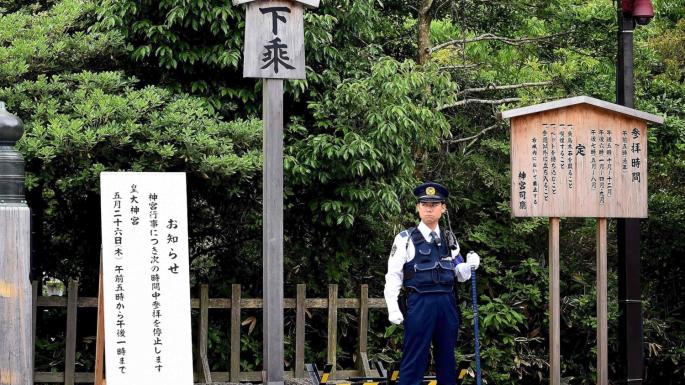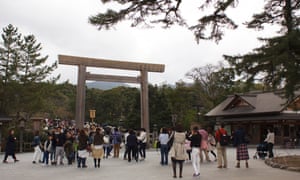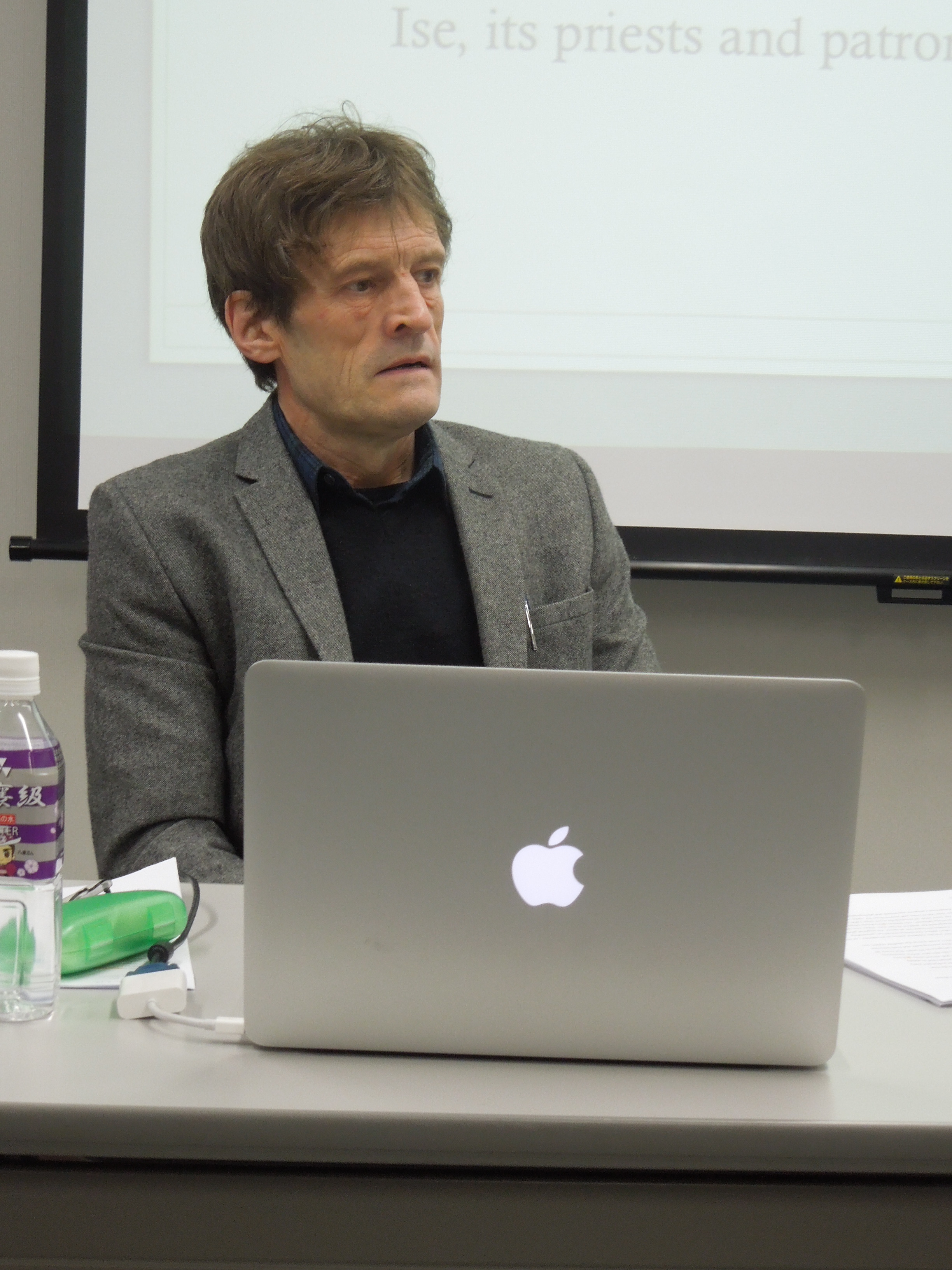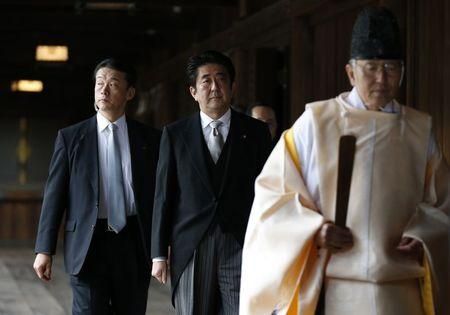
The Ise Grand Shrine has strong links to conservative nationalists who are campaigning to change Japan’s pacifist constitution (Manan Vatsyayana/Getty)
Abe’s cunning strategy to reassert State Shinto might backfire as the attention of the world is drawn to the political agenda of the Japanese right-wing this week. Justin McCurry here writing in The Guardian exposes some of the ulterior motives underlying the campaign to reassert the respectability of Ise and Yasukuni. Green Shinto has written before of Shinto Seiji Renmei (Shinto Association of Spiritual Leadership), the political wing of Jinja Honcho, and its intention to reimpose the prewar centrality of Shinto. By all accounts, the Nippon Kaigi are even more extreme.
A similar piece has appeared in The Times, written by Richard Lloyd Parry, the Asia Editor, headlined, ‘G7 leaders warned off shrine visit in Japan’. The article, available only to those who paid for subscription, tells of religious leaders and scholars in Japan urging the foreign leaders not to fall for Abe’s agenda.
************
G7 in Japan: concern over world leaders’ tour of nationalistic shrine
Justin McCurry in Ise, Wednesday 25 May 2016

With an impeccably observed combination of bowing and handclapping, the pilgrims give thanks to Amaterasu, the mythological sun goddess from whom all of Japan’s emperors are said to be the direct descendants.
Behind them, hundreds more slowly make their way up the steps in front of the hidden main sanctuary, waiting their turn to pray at Ise Jingu, Japan’s most revered Shinto shrine.
The millions of people who visit Ise Jingu every year will soon by joined by Japan’s prime minister, Shinzo Abe, and other leaders of the world’s richest nations during the G7 summit in nearby Ise-Shima, which begins on Thursday. The shrine, Abe said, “is a very good place to get in touch with the Japanese spirit.
“I wanted to choose a place where world leaders could have a full taste and feel of Japan’s beautiful nature, bountiful culture, and traditions,” added Abe, whose determination to visit the shrine was key to holding the summit in Ise, a small town many believe is poorly equipped to host a major international event.
But Abe, one of the shrine’s most fervent devotees, has drawn criticism that he is attempting to use the shrine to promote his conservative political agenda.
Under Abe, Japan’s indigenous religion is enjoying a political revival, seven decades after its close ties with militarism ended with Japan’s defeat in the second world war.
That Ise Jingu, actually a collection of 125 shrines dating back 2000 years, is a place of beauty and contemplation is beyond dispute. But its role at the heart of the Abe-led Shinto revival would make a G7 leaders’ visit more than a carefree stroll admiring the shrine’s sprawling ancient forest and crystal-clear river.
Abe and most members of his cabinet are members of the Shinto Seiji Renmei (Shinto Association of Spiritual Leadership), an influential lobbying group that counts more than 300 MPs among its members. The association has called for the removal of pacifist elements from Japan’s US-authored constitution – a key Abe policy goal – increased reverence for the emperor, and a state-sponsored ceremony to honour Japan’s war dead at Yasukuni, a controversial war shrine in Tokyo.

John Breen, professor at Kyoto’s Nichbunken
The choice of venue is “very closely connected” to Abe’s strong ideological connections with Shinto and its revisionist political agenda, said John Breen, a professor of Japanese history at the International Research Centre for Japanese Studies in Kyoto. It is “a perfect fit with his active involvement with the Shinto Seiji Renmei, and its aim of bringing Shinto into the heart of government”, Breen added.
While Abe has stayed away from Yasukuni shrine in Tokyo since his controversial pilgrimage there in December 2013, his frequent to Ise Jingu have formed the spiritual – and political – backdrop to his three-and-half years in office.
Just 44 MPs belonged to the Shinto association in 1984, but by 2014 the number had grown to 268, or 37 percent of all parliamentarians. Abe’s cabinet included 14 association members when he took office in 2012; by last year they filled 16 of 19 ministerial posts.
“Shinto is not a universal religion, and it’s inherently nationalistic,” said Koichi Nakano, a politics professor at Sophia University in Tokyo. “I already felt rather uncomfortable when Barack Obama was taken to Meiji Shrine last time he visited Japan, and it would be no less disturbing to see the G7 leaders being used to legitimise Shinto, given its reactionary and nationalistic positions on so many issues.”
Many of the Shinto association’s aims overlap with those of another increasingly influential group, Nippon Kaigi (Japan Conference), whose 38,000 members, including Abe and most of his cabinet, believe that Japan “liberated” Asia from Western colonial powers, and that the postwar constitution has emasculated the country’s “true, original characteristics”.
Likened by some to the Tea party in the US, Nippon Kaigi believes that Japan’s postwar education system promotes a “masochistic” view of its modern history; under pressure from its members several school authorities have adopted textbooks that gloss over or ignore Japan’s wartime atrocities.
Abe and his allies belong to a conservative school of thought that seeks closer military ties to Washington, yet want to roll back reforms made during the US-led postwar occupation, which began with the then emperor, Hirohito, renouncing his divine status as a “living god” and marked the end of state Shinto’s role as the spiritual bedrock of Japanese militarism.

“It’s good that I’m Japanese,’ runs the type of patriotic poster often seen at Shinto shrines
Amid mounting criticism of his troubled economic programme, Abe must be careful to stage-manage a leaders’ trip to Japan’s holiest site, said Michael Cucek, an adjunct professor at Waseda University in Tokyo. “Serving as the tour guide for the leaders of the G7 as they shuffle about inside the Ise precincts will add little to Abe’s reputation as a leader,” he said.
The reasons Cucek offers for Abe’s strong Shinto beliefs could give other G7 countries pause for thought. “Abe promotes himself as bridge between Japan’s past and its future, vaulting from Japan’s glorious traditions, over the post-1945 years of weakness, socialism and godlessness, to a beautiful, brave new Japan people by beautiful, brave new Japanese,” Cucek said. “Shinto gives him a direct link to pure Japaneseness, unsullied by association with dominant powers and their alien traditions.”
Japan’s foreign ministry confirmed this week that G7 leaders will take time out of their discussions to visit Ise Jingu. “Prime Minister Abe wishes for the G7 leaders to have the chance to visit Ise Jingu and share the dignified and solemn air of the shrine,” a foreign ministry spokesperson told the Guardian.
The British embassy in Tokyo said only that it was “aware” that Abe would like David Cameron and other leaders to visit Ise Jingu, while the French embassy said President Francois Hollande was “keen” on seeing the shrine.
“Ise Shrine is clearly an important historical and cultural site, so it would usually not be seen as a problematic place to visit,” said Mark Mullins, professor of Japanese studies at the University of Auckland. “But given that this religious site is central to the larger political vision Abe has in common with the Shinto Association for Spiritual Leadership, it will undoubtedly be viewed by critics as a strategy to gain legitimacy for their shared neonationalist agenda.”
A Japanese government official played down speculation that Abe would attempt to make political capital out of a leaders’ visit to Ise Jingu. Abe, the official said, “will be determined not to project any perception” that he is ignoring the constitutional separation of religion and state, adding: “Ise Jingu is a place where silence is golden, and politicking of any sort is its worst enemy.”
Kikuko Nishide, who runs a small museum near Ise Jingu, said she hoped G7 leaders would “experience the power of the forests and the shrine buildings and get a proper feel for Shinto and the spirit of the Japanese people”.


I appreciate this blog for the quality of some articles. But it amazes me that despite of having solid cultural and ritual knowledge you’re just rejecting all the aspects of shinto you disagree with. Just taking what you like and throwing what you dislike of it. That’s not the way things works. Especially when these aspects are the very roots and fondamental aspects of this cult.
“Shinto is not a universal religion, and it’s inherently nationalistic,” said Koichi Nakano
Which is the obvious truth. If you wish to reform Shinto and make it “evolving” or “moving forward”… by suppressing all it’s nationalistic compounds, then the result won’t be Shinto anymore but something else. Free to you to create your own custom religion but have the honesty to make things clear. I suggest to change the name of this blog into something like “mygreenshinto”.
Respect foreign cultures. The way they handle THEIR things have nothing to do with us.
You must live in a very curious world if you think foreign cultures have nothing to do with us… Perhaps you haven’t noticed that we live in the twenty-first century and a global society. And rejecting things you disagree with is called thinking. And responsibility. From what you say, you strike me as the kind of person who would close their eyes to injustice and walk on by in the happy belief it’s ‘nothing to do with us’. Fortunately the world comprises other sorts of people…
What is the “injustice” of the Japanese people paying homage to their ancestors?
As explained in the article, the political agenda behind it.
Genetically speaking, people are 99% identical and there is no biological basis for race. Anyone who says otherwise is a bigoted quack. That being said, there is no place for nationalism in our modern world.